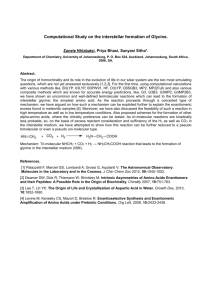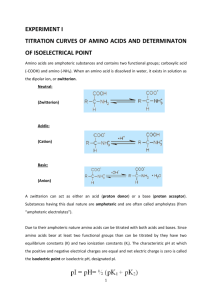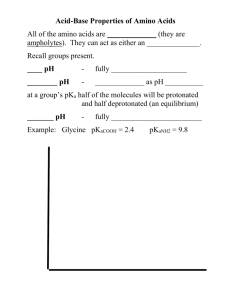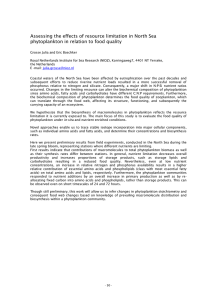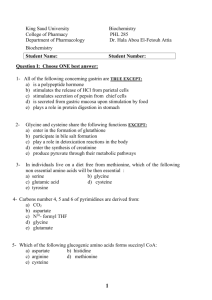Uptake of glycine by natural ... communities P. Wheeler1 and B. North
advertisement
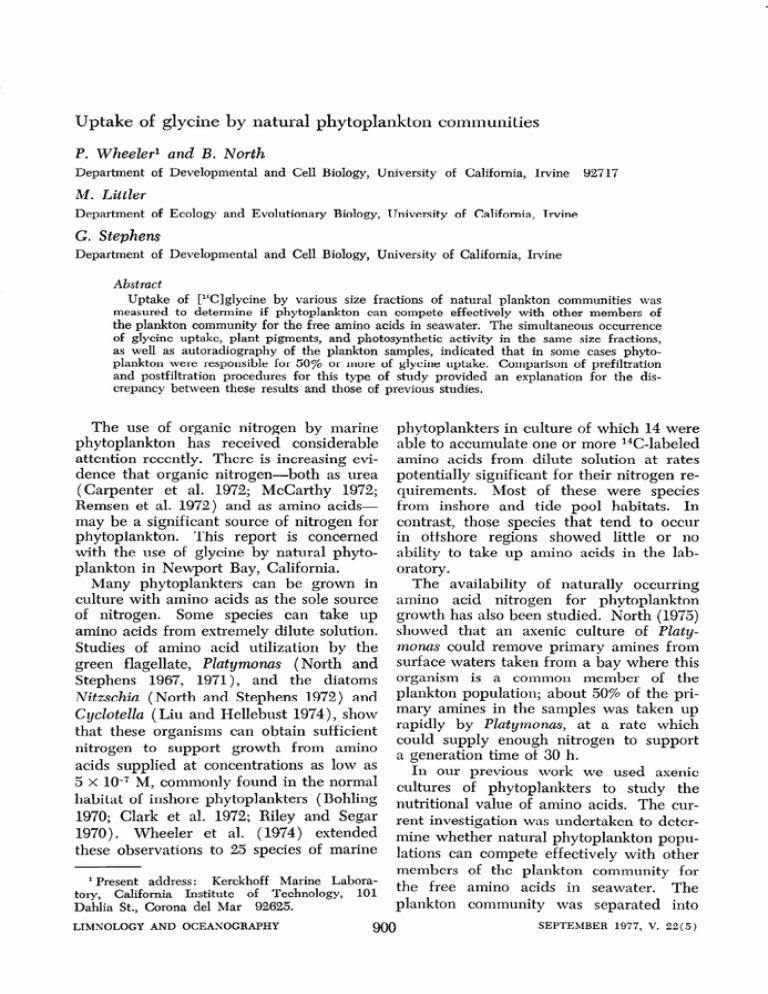
Uptake of glycine by natural phytoplankton communities P. Wheeler1 and B. North Department of Developmental and Cell Biology, University of California, Irvine 92717 M. Littler Department of Ecology and Evolutionary Biology, University of California, Irvine G. Stephens Department of Developmental and Cell Biology, University of California, Irvine Abstract Uptake of [14C]glycine by various size fractions of natural plankton communities was measured to determine if phytoplankton can compete effectively with other members of the plankton community for the free amino acids in seawater. The simultaneous occurrence of glycine uptake, plant pigments, and photosynthetic activity in the same size fractions, as well as autoradiography of the plankton samples, indicated that in some cases phytoplankton were responsible for 50% or more of glycine uptake. Comparison of prefiltration and postfiltration procedures for this type of study provided an explanation for the discrepancy between these results and those of previous studies. The use of organic nitrogen by marine phytoplankton has received considerable attention recently. There is increasing evidence that ‘organic nitrogen-both as urea (Carpenter et al. 1972; McCarthy 1972; Remsen et al. 1972) and as amino acidsmay be a significant source of nitrogen for phytoplankton. This report is concerned with the use of glycine by natural phytoplankton in Newport Bay, California. Many phytoplankters can be grown in culture with amino acids as the sole source of nitrogen. Smome species can take up amino acids from extremely dilute solution. Studies of amino acid utilization by the green flagellate, Platymonas (North and Stephens 1967, 1971), and the diatoms Nitzschia (North and Stephens 1972) and Cyclotella ( Liu and Hellebust 1974)) show that these organisms can obtain sufficient nitrogen to support growth from amino acids supplied at concentrations as low as 5 x 1O-7 M, commonly found in the normal habitat of inshore phytoplankters (Bohling 1970; Clark et al. 1972; Riley and Segar 1970). Wheeler et al. (1974) extended these observations to 25 species of marine Marine Labora1 Present address : Kerckhoff tory, California Institute of Technology, 101 Dahlia St., Corona de1 Mar 92625. LIMNOLOGY AND OCEANOGRAPHY 900 phytoplankters in culture of which 14 were able to accumulate one or more 14C-labeled amino acids from dilute solution at rates potentially significant for their nitrogen requirements. Most of these were species from inshore and tide pool habitats. In contrast, those species that tend to occur in offshore regions showed little or no ability to take up amino acids in the laboratory. The availability of naturally occurring amino acid nitrogen for phytoplankton growth has also been studied. North (1975) showed that an axenic culture of Platymenus could remove primary amines from surface waters taken from a bay where this organism is a common member of the plankton population; about 50% of the primary amines in the samples was taken up rapidly by Platymonas, at a rate which could supply enough nitrogen to support a generation time of 30 h. In our previous work we used axenic cultures of phytoplankters to study the nutritional value of amino acids. The current investigation was undertaken to determine whether natural phytoplankton populations can compete effectively with other members of the plankton community for the free amino acids in seawater. The plankton community was separated into SEPTEMBER 1977, V. 22 (5) Glycine several size fractions before incubation with [ 14C] glycine. This fractionation, along with simultaneous measurement of photosynthetic carbon fixation and the chlorophyll content of each fraction, indicated which elements of the plankton community accumulated the labeled glycine. In addition, autoradiography of plankton cells provided direct information about accumulation of [ 14C] glycine. Methods The experiment was performed four times (May and June 1974, February and August 1975). The experimental site was about 0.1 km offshore and 0.8 km from the entrance of Newport Bay. The water was about 3 m deep, salinity ranged from 30from 33%0, and the water temperature 14”-20°C. The average Secchi depth was about 2.0 m, giving an extinction coefficient of 0.85. A 20-liter seawater sample was collected from just beneath the surface water and processed as follows. Measurement of natural primary amines -Subsamples (200 ml) were filtered through 0.45-p” Millipore membranes and stored on ice until return to the laboratory for the determination of primary amine concentration with Fluorescamine reagent ( Roche ) ( North 1975 ) . Sixe separation-Size fractions were obtained by filtering a separate aliquot through one of five filters: 233-, 116-, or 25pm silk bolting cloth, 3-p” Flotronics ( silver ) , or 0.45-p” membranes. The three larger size fractions were filtered by gravity. For the <3-pm and <0.45-pm fractions, large particles were first removed with the 25-pm filter, and then the samples were passed through the smaller size filter with mild pressure applied to a 50-ml syringe, For the two finer filters, a new one was used for every 100 ml of sample to prevent changes in effective pore size from clogging of the filter. The filtrates were used as the incubation samples. Our selection of netting and filters was based on the work of Sheldon and Sutcliffe (1969) and Sheldon (1972). We examined preserved uptake 901 samples from each size fraction microscopically to determine the effective size separation and the extent of mechanical damage. We routinely separated particles by filtration before incubation with labeled substrate. Prefiltration eliminates changes in the distribution of label in different size fractions by grazing or loss of accumulated label due to cell damage during filtration (Holmes 1958; Lasker and Holmes 1957; McCarthy et al. 1974). Derenbach and Williams ( 1974 ) and Williams ( 1970) have separated particles by filtration after incubation with labeled substrate. Such postfiltration avoids underestimates of substrate utilization due to damage to organisms by filtration before incubation. Both procedures are subject to criticism, and the need for comparison of results obtained with each procedure on parallel samples has been noted ( Berman 1975). In the August experiment we measured [ 14C] glycine uptake using both prefiltration and postfiltration on duplicate samples. This allows direct comparison of our results with the measurements of heterotrophic activity made by Williams ( 1970). Analysis of plunt pigments-A 15-liter subsample was filtered through 233-pm netting to remove larger zooplankton and stored on ice in plastic bottles with 2 drops 1% MgC03 liter-l seawater until return to the laboratory. Duplicate LO-liter samples were then filtered as described above. The particulate material in each size fraction was collected on Millipore AA filters; pigments were extracted with 90% acetone and analyzed spectrophotometrically. The Parsons-Strickland equations (Strickland and Parsons 1968) were used to calculate chlorophyll a and total carotenoid concentrations. Photosynthetic rate- [ ‘C] CO, uptakeSamples (200 ml) of each size class were placed in light and dark bottles with 10 ,Gi [ 14C] bicarbonate. Aliquots ( 10 ml) were removed immediately, filtered, and stored on ice for measurement of initial levels of bicarbonate radioactivity. The bottles were incubated from 0900 to 1300 902 Wheeler et al. hours in situ, 0.3 m below the surface, where light extinction was <20%. At the end of 4 h, photosynthesis was stopped with 0.5% Formalin. Particulate material from quadruplicate 25ml samples was collected on 0.45~,um Millipore filters and the accumulated 14C counted by liquid scintillation. Ambient levels of bicarbonate and rates of photosynthesis were determined according to Strickland and Parsons ( 1968). This technique for determination of photosynthetic rate has several potential sources of error. Retention of dissolved radioactive substances by membrane filters may add significantly to the radioactivity in particulate matter on the filter (Nalewajko and Lean 1972). We measured the radioactivity in refiltered samples of the experimental filtrates and found that such retention was insignificant in the large size fractions (<233, <116, and <25 pm), but accounted for most or all of the radioactivity in the small size fractions and the dark controls. Another source of error in the photosynthetic assimilation measurements is the loss of 14C organic matter from the cells that could result from the use of Formalin and from the normal excretion of 14C In the June experiment, photosynthates. we measured the radioactivity remaining in the medium after acidifying the filtrate to remove residual [ 14C] bicarbonate, which is due to loss or excretion of soluble photosynthetic products (Schindler et al. 1972). Radioactivity was measured in acidified samples from the light bottles at the beginning and end of the incubation period. From 5-12% of the total [14C]C08 assimilated by the three larger size fractions was present as labeled organic material in the medium. No significant loss or excretion of organic material occurred in the smaller size fractions. The photosynthetic rates in Fig. 1 were not corrected for this loss or excretion and probably represent slight underestimates for the larger phytoplankton. [%]gZycine uptake-Duplicate 200-ml samples from each size class were incubated with 4 &i of uniformly labeled [ 14C] glycine ( sp act 89-106 mCi mmole-l ) . Formalin ( 0.5% ) was added to one bottle immediately to serve as a control and to provide a measure of initial radioactivity. Both bottles were then incubated as described above. After 4 h, uptake in the second bottle was stopped with Formalin. To estimate glycine uptake, we filtered quadruplicate 25-ml samples and counted radioactivity as described above. We also measured [ 14C] CO2 respired during incubation with [ 14C]glycine. A 2-ml sample from each incubation bottle was placed in a test tube and closed with a serum stopper. A cup containing 3 drops 10% KOH was suspended inside each tube. One drop of 6 N HCl was injected into the sample to drive off any [14C]COe, and samples were left overnight. The KOH solution containing the absorbed [14C]COa was then removed from the cup, made up to 1 ml with glass distilled water, and 14C activity in it counted by liquid scintillation. From lo25% of accumulated [lC]glycine reappeared as acid-volatile 14C, presumably due to respiration of glycine and subsequent release as [14C]COa. This is consistent with earlier measurements for glycine utilization by Platymonas and Nitzschia (Stephens and North 1971) and similar to the 12% excretion found for photosynthetic [ 14C] CO2 utilization. Since respiration was not measured in all of the experiments, the glycine uptake rates were not corrected for respiration and are, thus, slight underestimates. The use of Formalin to stop glycine uptake may have resulted in a further underestimate of glycine uptake if a significant amount of soluble labeled material was lost from the cells. However, if the loss is similar to that measured during the photosynthetic assimilation of carbon (i.e. 12% max), the error introduced does not affect our conclusions. Autoradiography-A 200-ml sample was filtered through 233-pm netting. To this, 50 &i [ 14C] glycine was added and the sample was immediately separated into two portions : 1 ml Lugol’s iodine solution was added to one portion to serve as a control. Both bottles were incubated in situ as described above. Samples were prepared for autoradiography as follows. A 15-ml ali- Glycine quot from each incubation bottle was allowed to settle overnight in a Silicladtreated test tube. The supernatant was removed by suction, and the cells were dehydrated by an initial slow addition of 50% dioxane to give a total volume of 5 ml. The procedure was repeated three times, using 100% dioxane. After removal of the last dioxane supernatant-leaving about 0.5 ml -0.5 ml or 1.0 ml of 75% Permount in dioxane was added to each tube. Samples were left overnight, then spread on slides and dried. The slides were dipped in subbing solution (1.0 ml of 40% sodium silicate, 1.0 ml of coned NH40H, 98 ml of distilled water: Brock and Brock 1968) to assure proper adhesion of the photographic emulsion, Finally, the slides were dipped in NTB3 emulsion at 40°C three times, exposed for 3-5 days, and developed with Kodax D-19 developer and rapid fixer. Species identification and cell countsSamples ( 100 ml) of each size fraction were preserved with 1 ml of Lugol’s iodine solution, Phytoplankton cells were identified and counted by the sedimentation method (Utermiihl 1931, 1958): 50 ml of unconcentrated sample were settled for 4 days in an ll.O-cm-tall sedimentation chamber and the base of the chamber was examined with an inverted microscope ( Wild M 40). Alternate rows were counted, under 100X magnification for the larger cells ( >50 pm) and 400x for small cells, to a minimum of 100 cells. Lund et al. (1958) found this methodology to yield an accuracy >80% at the 0.95 level of confidence. Calculations-Glycine uptake rates were calculated from the equation v=c(Sn+A) Cpt ’ where V = nmoles taken up liter-l h-l; c contained in population = radioactivity (cpm liter-l); Sn = concentration of substrate already present in the seawater sample ( ,ccM) ; A = concentration of added substrate (PM ); C = cpm PCi-l in system used; p = number of &i added to sample; t = incubation time (h) (Parsons and Strickland 1962 ) . The concentration of uptake 903 glycine already present in the seawater, Sn, was roughly calculated as follows: total primary amines in the samples were estimated at 1.1, 2.4, 2.1, and 0.9 ,uM ( glycine equivalents), from the Fluorescamine analyses. About half of the primary amines in Newport Bay water is probably in the form of free amino acids (North 1975). Free amino acids in seawater normally consist of about five parts each glycine and serine and two parts each of six other amino acids (Andrews and Williams 1971; Chau and Riley 1966; Degens et al. 1964; Webb and Wood 1967). Thus, glycine may account for about 23% of the total free amino acids and about 12% of the primary amines in Newport Bay water. Using these figures we estimated the natural glycine concentration as 0.1, 0.3, 0.2, and 0.1 PM respectively in the four experiments. Since glycine was added to the samples at levels of 0.1-0.2 PM, the uptake rates were about twice those occurring naturally. Assuming that the uptake rates were linearly related to substrate concentration in the pmolar range, we report the glycine uptake rates ( Fig. 1) as nmoles glycine taken up per liter per hour at the natural glycine concentration. Results To facilitate interpretation of the results with respect to particle size, we present the data ( Fig. 1) by size classes (e.g. the activity that could be attributed to particles 3-25 pm was calculated by subtracting the activity in particles <3 pm from the activity in particles <25 pm). In one case, this resulted in a negative value: in June there was less glycine uptake associated with the <116-pm fraction than with the <25-pm fraction. The values for pigment content and photosynthetic activity in the same experiment showed the usual relation to size, so the discrepancy probably represents a filtration or sampling error and glycine uptake for that sample (25-116 pm) is reported as zero. The relative amounts of plant pigments, [ 14C] CO2 assimilation, and glycine uptake Wheeler et al. I 116-233pm ~:_,_: I- .’ ‘. 25-Il6,um Elgr 3 -25pm .‘.,. r”l ‘+i. 0.45 - 3pm c 0.45pm I I EXPERIMENT MAY 1974 Fig. 1. Plant pigments, I EXPERIMENT JUNE photosynthesis, 2’ FEBRUARY 1974 and glycine for each size class varied with the population sampled. In the May experiment, nanoplankton (3-25 ,um) accounted for 97% of the cell numbers in the population (Table 1). Corresponding to this predominance of nanoplankton, we found that essentially all of the plant pigment and about EXPERIMENT uptake 3 1975 EXPERIMENT AUGUST 4 1975 in each size class. 90% of the [ 14C]C02 assimilation was in 3-25-pm particles ( Fig. 1). Essentially all of the glycine uptake was also associated with the 3-25-p” particles ( Fig. 1). In June there was a considerable increase in the density of net phytoplankton, most of which was due to the abudance of Chae- Glycine Table 1. Phytoplankton taxa and their abundances (cells liter?) during the four uptake experiments. X indicates that a species was present, but not in quantities that allowed reliable calculation of abundance. A. Net phytoplankton (>Wm) May BACILLARIOPHYTA Asterionella japonica Chaetoceros debilis Chaetoceros didymus Chaetoceros sp. Coscinodiscus centralis var. pacifica Ditylum brightwellii Grammatophora marina Licmophora flabellata Naviculoid diatoms (>50w) Nitzschia longissima Rhizosolenia alata Rhizosolenia delicatula Stauroneis sp. Total Jun Feb 81,101 4,506 1. Continued. B. Nanophytoplankton (3pm to 25um) CHLOROPHYTA Platymonas sp. Aug X X X X 9.011 X X 13,517 1974 May 33,792 CRYPTOPHYTA Hillea sp. 81 Hillea sp. 12 Total CYANOPHYTA Oscillatoria 504,627 829,030 Feb 108,134 108,134 901,120 144,179 A'% 72,090 504,627 865,075 36,045 540,672 1,369,702 1,369,702 36,045 sp. PYRRHOPHYTA Gymnodinium simplex TOTAL 1975 JUn 36,045 CHRYSOPHYTA Chrysophyte bl 1,153,434 27,034 Table 905 BACILLARIOPHYTA Naviculoid diatoms (<50pm) 1975 1974 uptake X 36,045 1,946,419 2,378,956 252,313 108,135 9,011 X X 1,279,591 CHRYSOPHYTA Distephanus speculum Ebria tripartita 18,023 33,792 X EUGLENOPHYTA Eutreptia sp. X PYRRHOPHYTA Ceratium divaricatum Ceratium furca Ceratium fusus Ceratium lineatum Ceratium tripos Dinophysis ovum Dinophysis tripos Gonyaulax catenata Gonyaulax polyedra Gyrodinium spirale Gymnodinium splendens Gymnodinium sp. Noctiluca miliaris Oxyphysis oxytoxoides Oxytoxum diploconus Oxytoxum scolopax Oxytoxum sp. ii1 Oxytoxum sp. i/2 Peridinium depressum Peridinium divergens Peridinium steinii Peridinium sp. Polykrikos kofoidi Prorocentrum gracile Prorocentrum micans Total 11,264 33,792 63,079 TOTAL 63,079 X X 6,758 X X X X X X 1,802 X X 901 2,253 X X X 2,253 2,253 4,506 58,573 6,758 X 9,011 9,011 2,253 X X X 6,758 4,506 2,259 X 4,506 27,034 52,265 1,331,856 X X 65,331 15,782 83,354 49,574 toceros debilis (Table 1). Total pigment content and [ 14C] CO2 assimilation were nearly double those in the first experiment, with substantial increases in the larger size particles ( Fig. 1). Fifteen to twenty percent of the plant pigments and 30% of the [‘“Cl CO8 assimilation was associated with particles >25 pm. Half of the glycine was taken up by particles >25 pm, half by 3-S-pm particles. The February experiment was performed during a red tide. Nanoplankton was very scarce and the net plankton was dominated by the dinoflagellate Gonyaulax polyedra (Table 1). Most of the plant pigment was found in the 3-25,~~r-r particles. A large portion of this was due to Gonyaulux which was damaged during filtration and therefore able to pass through the 25pm netting (Table 2). Assimilation of [ 14C] COa was so low in all the size fractions that significant differences could not be detected ( Fig. 1). Half the glycine was taken up by the 116-233-pm particles, and half by 3-25 pm particles. In the August experiment there was little phytoplankton. Most of the plant pigment was in the 3-25pm particles and was due to a naviculoid diatom and two nanoplankters (Table 2). Assimilation of [‘“Cl CO2 was not measured. The amount of glycine taken up by 116-233-, 25-116, and 3-25 pm particles was 25, 50, and 25% for the prefiltered samples ( Fig. 1) . Postfiltration resulted in a shift of the accumulated label to the smaller size fractions: 50% of the label was found in the 0.453-pm particles (Fig. 2). In the last two experiments, the composition of the phytoplankton in each size fraction was determined by microscopic exami- 906 Wheeler et al. Table 2. Abundance of phytoplankton in each size class from February Phytoplankton and August (Cells/liter) Aug 1975 Feb 1975 Size class Larger (urn) Phytoflagellates Gonyaulax a naviculoid Phytoflagellates forms 0 108,135 0 0 0 0 74,343t 0 0 0 polyedra. diatom. nation of preserved samples (Table 2). In February, about half of the large plankton was in the 25116-pm size fraction, the remainder of the large plankton and most of the nanoplankton ( phytoflagellates ) in the 3-25pm size fraction. In August all of the phytoplankton was in the 3-25-p” fraction. Thus, filtration did result in some separation of the activities of large plankton, phytoflagellates, and free bacteria. The preserved samples were also examined for cell fragmentation (Table 3). Flocculated organic matter was considerably more abundant in the smaller size fractions. Since each successive size fraction (from <233 to <0.45 pm) contained a progressively smaller percent of the total particulate material, the increase of flocculated organic matter can be attributed to the fragmentation of cells and detritus during filtration. The effect of this mechanical disruption on ~1116-233/m 13-25pm a a0.45-Sp/m 25-116m m-c :._’ PREFILTERED Fig. 2. Glycine filtered samples. Larger 36,044 0 180,224 36,045 0 0 47,309" 81,101 0 0 116-233 25-116 3-25 0.45-3 co.45 *Mostly TMostly forms experiments. uptake Discussion The concentration of plant pigments and [ 14C] CO2 assimilation rates are within the range for nutrient-rich water and nearshore populations (Anderson and Zeutschel 1970; Curl and Small 1965; Ignatiades 1973; W. Thomas 1970; J. Thomas 1971). Total glycine uptake is also similar to that for other heterotrophic populations ( Hollibaugh 1976; Schell 1974). More than 80% of the photosynthetic pigments and a comparable fraction of photosynthetic 14C assimilation occurred in phytoplankton in the 3-25pm size class ( Fig. 1)) in agreement with reports by other investigators (Malone 1971a,b; McCarthy et al. 1974) that nanoplankton play a dominant role in Table 3. Abundance of flocculated organic matter (clumps liter-l) in each size fraction from February and August experiments. 0.45,um M POSTFILTERED in prefiltered the interpretation of our results and conclusions is discussed below. Representative autoradiographs from the experiments are shown in Fig. 3. and post- Flocculated Size fraction <223 cl16 <25 <3 co.45 (urn) organic matter Feb 1975 Aug 1975 0 0 42,803 72,090 2,253 0 0 18,022 18,022 45,056 -~ 908 Wheeler et al. primary productivity. This same size class was responsible for 56% or more of the glycine uptake ( Fig. 1). The simultaneous occurrence of phytoplankton and [ 14C]glycine activity in the same particle size class does not necessarily mean that phytoplankton are responsible for the glycine uptake. Bacteria attached to phytoplankton or to detrital particles may be responsible for some of it, although Droop and Elson ( 1966) found that pelagic diatoms are free of bacteria. Furthermore our results showing the distribution of the accumulated label in the various size classes in conjunction with autoradiography and the comparison of pre- and postfiltration procedures, provide strong qualitative evidence that phytoplankton can compete with both free and attached bacteria for glycine. Autoradiographs showing labeled cells of some of the dominant phytoplankters support the conclusion that phytoplankton are responsible for at least some of the glycine uptake. Detritus was present in all of our samples. Bacteria are often attached to such particles and may be responsible for some of the glycine uptake measured in the larger size fractions. For example, 50% of the glycine in the third experiment was taken up by 116-233-pm particles, and 75% of the glycine in the fourth experiment by 25-233-pm particles. In both of these cases the uptake may be due to bacteria on detritus, since it cannot be associated with large net plankters. In the autoradiographs detritus was usually in clumps which also contained phytoplankton cells, and it was not possible to attribute the accumulated label specifically to phytoplankton or to attached bacteria. However, large numbers of bacteria are not attached to particulate matter, such as plankton or detritus, but free-living (Wiebe and Pomeroy 1972). Free bacteria presumably would be present in our 0.453-pm size class. No significant glycine uptake occurred in particles <3 pm when the size separation was made before incubation. Williams ( 1970) examined uptake of a mixture of 14C-labeled amino acids by natu- ral plankton populations as a function of plankton size. Since 68% of the radioactive substrate ( average for both [ 14C] glucose and amino acids) was taken up by organisms passing through a 3+m filter, he concluded that bacteria were responsible for most amino acid uptake. However, Williams separated the plankton into size classes after incubation with labeled substrate. When we compared the prefiltration and postfiltration procedures, it was clear that postfiltration results in a shift of the distribution of labeled particles into smaller size classes (Fig. 2). Detrital particles and living phytoplankters could both be broken up by the filtration process. Although fragmentation of detritus should not lead to a difference in the distribution of label in the various size fractions between prefiltered and postfiltered samples, many phytoplankters are very fragile, and fragmentation of these organisms could very well lead to such a difference (Lasker and Holmes 1957). Cells seem to have been fragmented in our experiments, since microscopic examination of preserved samples showed that filtration increased the amount of flocculated organic matter in the smaller size fractions. If phytoplankters in a particular size class are damaged during filtration, the glycine uptake in the prefiltered samples for that size class is probably underestimated due to cell destruction, whereas in the postfiltered samples uptake by smaller size classes is probably overestimated due to retention of labeled cell fragments. Using prefiltration we found that all of the substrate was taken up by organisms retained by a 3+m filter; some of this can be attributed to phytoplankters, some may be due to bacteria attached to particles. However, none of the labeled substrate was taken up by free bacteria, if such bacteria were present. This contrasts markedly with data from the postfiltration procedure. Uptake of amino acids by plankton in the oligohaline Pamlico River Estuary has recently been studied by Crawford et al. (1974). They concluded on the basis of measured Kt values (concentrations at which uptake is half maximal) that bacte- Glycine ria were primarily responsible for the observed uptake. Since some of these Kt values are as high as those reported for cultures of planktonic algae (Hellebust 1970; Liu and Hellebust 1974; North and Stephens 1969, 1972), an algal contribution to uptake cannot be excluded solely on this ground. Crawford et al. did not determine uptake by size categories in their samples nor did they use autoradiography. However, it is also possible that the difference in their results is due to the low salinity of their samples (O-10%0). Our samples ranged from 30-33%0. Mitamura and Saijo (1975) have presented evidence that the contribution of bacteria to urea decomposition is minor compared to that of phytoplankton. Their results and ours strongly support the conclusion that phytoplankton can compete effectively with bacteria for dissolved organic nitrogen compounds in nearshore environments. References ANDERSON,G. C., AND R. P. ZEUTSCHEL. 1970. Release of dissolved organic matter by marine phytoplankton in coastal and offshore areas of the Northeast Pacific Ocean. Limnol. Oceanogr. 15: 402407. ANDREWS,P., AND P. J. WILLIAMS. 1971. Heterotrophic utilization of dissolved organic compounds in the sea. 3. Measurement of the oxidation rates and concentrations of glucose and amino acids in seawater. J. Mar. Biol. Assoc. U.K. 51: 111-125. BERMAN, T. 1975. Size fractionation of natural aquatic populations associated with autotrophic and heterotrophic carbon uptake. Mar. Biol. 33: 215-220. BOHLING, H. 1970. Untersuchungen iiber freie geloste Aminosauren in Meerwasser. Mar. Biol. 6: 213-225. BHOCK, M. L., AND T. D. BROCK. 1968. The application of micro-autoradiographic techniques to ecological studies. Mitt. Int. Ver. Theor. Angew. Limnol. 15. 29 p. CARPENTER,E. J., C. C. REMSEN, AND S. W. WATSON. 1972. Utilization of urea by some marine phytoplankters. Limnol. Oceanogr. 17 : 265-269. CHAU, Y. K., AND J. P. RILEY. 1966. The determination of amino-acids in sea water. Deep-Sea Res. 13: 1115-1124. CLARK, M. E., G. A. JACKSON,AND W. J. NORTH. 1972. Dissolved free amino acids in south- uptake 909 ern California coastal waters. Limnol. Oceanogr. 17: 749-758. CRAWFORD.C. C., J. E. HOBBIE, AND K. L. WEBB. 1974. The utilization of dissolved free amino acids by estuarine microorganisms. Ecology 55 : 551563. CURL, H., AND L. F. SMALL. 1965. Variations in photosynthetic assimilation ratios in natumarine ral, phytoplankton communities. Limnol. Oceanogr. 10 : R67-R73. DEGENS, E. T., J. H. REUTER, AND K. N. SHAW. 1964. Biochemical compounds in offshore California sediments and sea waters. Geochim. Cosmochim. Acta 78: 45-66. DERENBACH, J. B., AND P. J. WILLIAMS. 1974. Autotrophic and bacterial production-fractionation of plankton populations by differential filtration of samples from the English Channel. Mar. Biol. 25: 263-269. DROOP, M. R., AND K. G. ELSON. 1966. Are pelagic diatoms free from bacteria? Nature 211: 1096-1097. HELLEBUST, J. A. 1970. The uptake and utilization of organic substrates by marine phytoplankters, p. 223-256. In D. W. Hood [ed.], Organic matter in natural waters. Inst. Mar. Sci. (Alaska) Occas. Publ. 1. HOLLIBAUGH, J. T. 1976. The biological degradation of arginine and glutamic acid in seawater in relation to the growth of phytoplankton. Mar. Biol. 36: 303-312. HOLMES, R. W. 1958. Size fractionation of photosynthesizing phytoplankton. U.S. Fish. Wildl. Serv. Spec. Sci. Rep. Fish. 279, p. 69-71. IGNATIADE~, L. 1973. Studies on the factors affecting the release of organic matter by Skeletonema costatum (Greville) Cleve in field conditions. J. Mar. Biol. Assoc. U.K. 53: 923-935. LASKER, R., AND R. W. HoLhlEs. 1957. Variability in retention of marine phytoplankton by membrane filters. Nature 180: 12951296. LIU, M. S., AND J. A. HELLEBUST. 1974. Uptake of amino acids by the marine centric diatom Can. J. Microbial. 20: Cyclotella cryptica. 1109-1118. LUSD, J. W., C. KIPLISG, AND E. D. LE CREN. 1958. The inverted microscope method of estimating algal numbers and the statistical basis of estimations by counting. Hydrobiologia 11: 143-170. MCCARTHY, J. J. 1972. The uptake of urea by natural populations of marine phytoplankton. Limnol. Oceanogr. 17 : 738-748. -, W. R. TAYLOR, ASD M. E. LOFTUS. 1974. Significance of nanoplankton in the Chesapeake Bay Estuary and problems associated with the measurement of nanoplankton productivity. Mar. Biol. 24: 7-16. 910 Wheele !r et al. MALONE, T. C. p. The relative importance 197la. of nanoplankton and netplankton as primary producers in the California current system. Fish. Bull. 69: 779-820. 1971b. The relative importance of nannoplankton and netplankton as primary producers in tropical oceanic and neritic phytoplankton communities. Limnol. Oceanogr. 16: 633-639. MITA~IURA, O., ASD Y. SAIJO. 1975. Decomposition of urea associated with photosynthesis Mar. of phytoplankton in coastal waters. Biol. 30: 67-72. NALEWAJKO,C., AND D. R. LEAN. 1972. Retention of dissolved compounds by membrane filters as an error in the 14C method of primary production measurement. J. Phycol. 8: 37- 43. NOIITH, B. B. --> -, 1975. Primary amines in CaliUtilization by phytofornia coastal waters: Limnol. Oceanogr. 20 : 20-27. plankton. AND G. C. STEPHENS. 1967. Uptake anh assimilation of amino acids by PZatyBiol. Bull. 133: 391-400. nionas. A?rTD-. 1969. Dissolved amino Proc. Int. acids and Platynzonas nutrition. Seaweed Symp. (6th) Madrid, p. 263-273. 1971. Uptake and assimi, ASD -. lation of amino acids by Plutymonas. 2. Increased uptake in nitrogen-deficient cells. Biol. Bull. 140: 242-254. 1972. Amino acid transAND -. port in Nitzschia o&is Arnott. J. Phycol. 8: 64-68. PARSONS,T. R., AxD J. D. STRICKLAND. 1962. On the production of particulate organic carbon by heterotrophic processes in sea-water. Deep-Sea Res. 8: 211-222. RE~ISEN, C. C., E. J. CARPENTER, AND B. W. SCHROEDER. 1972. Competition for urea microorganisms. Ecology among estuarine 53 : 92 l-926. RILEY, J. P., AND D. A. SEGAR. 1970. The seasonal variation of the free and combined dissolved amino acids in the Irish Sea. J. Mar. Biol. Assoc. U.K. 50: 713-720. SCHELL, D. M. 1974. Uptake and regeneration of free amino acids in marine waters of SouthLimnol. Oceanogr. 19: 260east Alaska. 270. SCHINDLER,D. W., R. V. SCH~IIDT,AND R. A. REID. 1972. Acidification and bubbling as an al- ternative to filtration in determining phytoplankton production by the ‘*C method. J. Fish. Res. Bd. Can. 29: 1627-1631. SHELDON, R. W. 1972. Size separation of marine seston by membrane and glass-fiber filters. Limnol. Oceanogr. 17 : 494-498. -, AND W. H. SUTCLIFFE. 1969. Retention of marine particles by screens and filters. Limnol. Oceanogr. 14: 441-444. STEPHENS,G. C., AKD B. B. NORTH. 1971. Extrusion of carbon accompanying uptake of amino acids by marine phytoplankters. Limnol. Oceanogr. 16: 752-757. STRICKLAND,J. D., AND T. R. PARSONS. 1968. A practical handbook of seawater analysis. Bull. Fish. Res. Bd. Can. 167. THO~~AS, J. P. 1971. Release of dissolved organic matter from natural populations of marine phytoplankton. Mar. Biol. 11: 311-323. THOMAS, W. H. 1970. On nitrogen deficiency in tropical Pacific oceanic phytoplankton : Photosynthetic parameters in poor and rich water. Limnol. Oceanogr. 15 : 380-385. UTER~G~HL, H. 1931. iiber das umgekehrte Mikroskop. Arch. Hydrobiol. Planktonkd. 22: 643-645. -. 1958. Zur Vervollkommnung der quantitativen Phytoplankton methodik. Mitt. Int. Ver. Theor. Angew. Limnol. 9. 38 p. WEBB, K. L., AND L. WOOD. 1967. Improved techniques for analysis of free amino acids in sea water. Automat. Anal. Chem., Technicon Symp., 1966, p. 440441. WHEELER, P. A., B. B. NORTH, AND G. C. STEPHESS. 1974. Amino acid uptake by maLimnol. Oceanogr. 19 : rine phytoplankters. 249-259. WIEBE, W. J., AND L. R. POAIEROY. 1972. Microorganisms and their association with aggregates and detritus in the sea in a microMem. 1st. Ital. Idrobiol. 28 scopic study. ( suppl. ) : 325-352. utilization WILLIAMS, P. J. 1970. Heterotrophic of dissolved organic compounds in the sea. 1. Size distribution and relationship between respiration and incorporation of growth substances. J. Mar. Biol. Assoc. U.K. 50: 859- 870. Submitted: Accepted: 26 July 1976 8 February 1977

